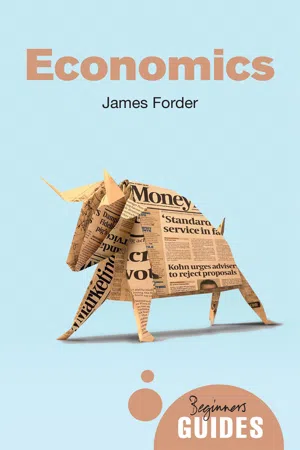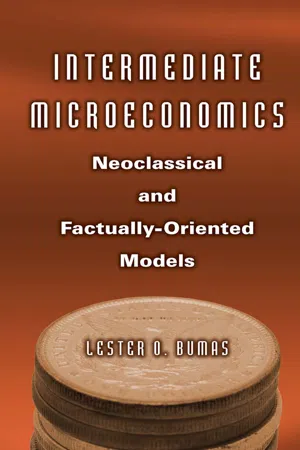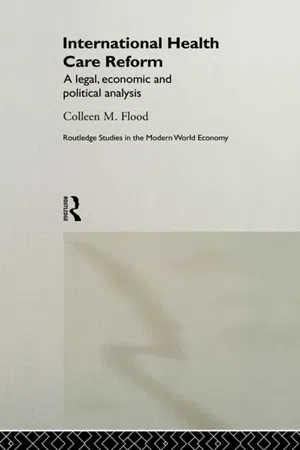Economics
Market Failure
Market failure occurs when the allocation of goods and services by a free market is inefficient, leading to a misallocation of resources. This can result from externalities, public goods, asymmetric information, or market power. In such cases, the market fails to achieve an optimal outcome, and government intervention may be necessary to correct the inefficiency.
Written by Perlego with AI-assistance
Related key terms
Related key terms
1 of 4
Related key terms
1 of 3
10 Key excerpts on "Market Failure"
- eBook - ePub
The Economics of Property and Planning
Future Value
- Graham Squires(Author)
- 2021(Publication Date)
- Routledge(Publisher)
It has so far been considered that markets can be conceptualised, although the workings of the market are not as clear and simple as classical economic market theory would suggest. As described earlier, there are limitations of not being able to internalise all costs and benefits, and third party external costs and benefits need to be recognised outside of the market transaction. Further market difficulties are their failure to efficiently allocate resources, where conventional free-market theory would suggest is when long-term equilibrium of supply and demand is always achieved. ‘Market Failure’ is the key concept for discussion here and is where the market fails to achieve an efficient allocation of resources. This inefficient allocation of resources certainly applies to environmental resources in their use, production, and consumption within places.Table 11 demonstrates the five main reasons why markets fail. The occurrence of monopolies is one way in which the efficiency of markets is restricted, as one supplier in the market would mean that they would be able to fix prices at a higher rate due to lack of competition. Lack of competition may be because there are barriers to entry into the market, for instance the telecommunications infrastructure has often been monopolised by companies. This monopoly power and domination in the telecommunications market has meant that prices are held artificially high without the ability of competitors to enter the market. This has prompted governments to step in and ensure that companies act in the interest of the consumers by breaking into smaller demerged entities with a lower percentage of market share.Table 11 Types of Market Failure and Descriptors
Source: AuthorType of Failure Descriptors Monopolies(including natural monopoly) • Few producers relative to the size of the market Externalities • External social and environmental costs, in addition to internal market costs Public goods (and common property resources) • No exclusive and non-rival • Owned by no one and used by anyone Weak property rights • Inability of institutions to establish well-defined property rights – market doesn’t function in a complete rational and bounded process Asymmetric information • Producers do not have the same information • Generates moral hazards and adverse selection Monopolies also occur for very practical reasons such as the strategic benefits of being a natural monopoly. A natural monopoly is where it makes sense to have only one producer in a certain market, especially if the addition of one extra unit is made means that a unit cost is lower. An example of a natural monopoly within a place is the utilities that service properties such as electricity, gas, water, and sewage. It would not make economic sense in terms of efficiency if several companies built these service infrastructures, as this would mean that there would be four or five cables and pipes servicing properties in a place when only one would suffice. The practical economic solution would be to have a well-regulated infrastructure that allowed service providers to lease and compete for the single physical infrastructure. Transport links between places would also be argued to form a natural monopoly and hence demonstrate that a complete free-market approach would be inefficient. The rail network that connects cities within national boundaries is often owned by a regulated coordinating body that lease out parts of the track to competitive tender. - eBook - ePub
Understanding Business: Markets
A Multidimensional Approach to the Market Economy
- Vivek Suneja, Vivek Suneja(Authors)
- 2005(Publication Date)
- Routledge(Publisher)
SECTION 4: Market Failure INTRODUCTION Markets are not infallible: they can fail to organise economic activity in a socially desirable fashion. Chapter 7, When markets fail by Sloman and Sutcliffe explores the various sources and dimensions of Market Failure. Markets may fail to generate socially efficient outcomes and may fail to deliver equitable outcomes. Various factors may lead to social inefficiencies, these include: externalities; public goods; the behaviour of monopolies and oligopolies; ‘inappropriate’ consumer preferences; lack of information; uncertainty; and the immobility of factors of production. Inequitable outcomes may be generated by an inequitable initial distribution of resources, unequal access to career advancing opportunities or an unequal distribution of bargaining power. Sloman and Sutcliffe investigate whether and how some of these Market Failures can be remedied, and what role the government can play in this process. The state may potentially use a wide array of instruments to correct Market Failure, such as the use of taxes and subsidies, provision of missing information, the creation or alteration of property rights, the establishment of laws and bodies to regulate economic behaviour and the direct provision of certain goods and services. State intervention is not without its problems though. Just as markets can fail, so can governments. ‘Government failure’ may be caused by a range of factors, such as the costs involved in gathering the required information, the inefficiency that may result due to lack of market incentives and the absence of adequate accountability. In recent years, many countries have reduced the degree of state intervention in their economies as a consequence of such considerations. They have also experimented with newer forms of state intervention, such as trying to regulate the production of certain goods and services rather than providing them directly through public enterprises - eBook - ePub
Economic Principles and Problems - A Pluralist Introduction
Special Sale for Roskilde University Basic Course in Socio-Economics
- Geoffrey Schneider(Author)
- 2023(Publication Date)
- Routledge(Publisher)
19 Market Failure and government failure The primary role for government in microeconomic marketsAccording to the standard mainstream economics model of consumer and producer behavior, in competitive markets firms produce the goods that consumers want at the lowest possible price. If the assumptions of this model hold, unregulated markets should be efficient in providing goods and services and no government intervention is necessary.However, economists have established eight major categories in which microeconomic markets fail to perform effectively. The Market Failures are as follows:- Imperfect information about unsafe products: As highlighted in Chapter 18, firms regularly produce products that are unsafe for consumers. Consumers are often unaware of those problems until it is too late.
- Unequal bargaining power in the labor market: It is regularly the case in capitalist economies that many laborers have few employment options and therefore lack the ability to bargain effectively with employers for decent wages and working conditions.
- Monopoly power and insufficient competition: In noncompetitive markets, monopoly power can allow firms to dominate markets, charging high prices without being particularly efficient.
- Negative and positive externalities: Many markets contain spillover costs or benefits that make market outcomes inefficient. Markets tend to overproduce goods that generate negative spillovers, such as goods whose production causes pollution. Markets underproduce goods that generate positive spillovers, such as education and health care.
- Failure to preserve common resources and the environment
- eBook - ePub
Economics
A Beginner's Guide
- James Forder(Author)
- 2016(Publication Date)
- Oneworld Publications(Publisher)
4 Market FailureSo, the price system and the profit motive are certainly important, and powerful. But it is widely observed that they can often lead to some very undesirable results as well. The most widely reported is surely the excesses of environmental damage all too clearly resulting from the pursuit of profit. But there are others. As far as economics is concerned, these sorts of things are ‘Market Failures’ – cases where, for understandable and perhaps remediable reasons, the price system delivers less than optimal results.Before considering specific cases of Market Failure, we should note that the definition of Market Failure in one way casts the net very wide, while in another it keeps the range of enquiry very narrow. The narrowness comes from the idea of optimality which is at work. Two near-enough equivalent ways of thinking of it are that the market has failed to deliver optimality when the price of goods or services is not equal to their marginal cost; or alternatively that there are unrealized, potential transactions which could make both parties better off. As that makes clear, no issues of moral worth, equality, or fairness are raised. Those factors are not the idea of ‘Market Failure’ at all.The breadth comes from the wide range of issues which can be seen to fit this definition. Two examples have already come up. The discussion of the problem in the used-car market was one. The other was in the discussion of ‘monopoly’ – or generally of the firm with a downward-sloping demand curve. Indeed, both of these feature routinely on textbook lists of Market Failure, and the cases like the used cars do so uncontroversially.Monopoly as a Market FailureThe case of monopoly is more peculiar. If there is the kind of relation between monopoly and innovation described in chapter 3 – so that the creation of temporary monopoly is the consequence of innovation, and monopoly profit the inducement for it – it seems strange to regard it as a failure of the market. One thought is that there might be other sources of innovation, but still it is hard to escape the view that there is some link between it and monopoly. Indeed, through the granting of patents, policymakers create or protect monopoly. The reason is that many ideas protected by patents would otherwise be too easy to imitate, and profits from the innovations would be too short-lived to induce the investment required to make them. An often-cited example is that of the development of new medical drugs. It is partly a hit-and-miss process, requiring expensive experimentation, but when a new drug is devised, it is usually easy to copy. The making of chemically identical copies would put its production into near-perfect competition, making it impossible to recoup the expenses of the experimentation. That means there would be no profit to be made in undertaking the experiments in the first place. One response might be to nationalize the research, so that it would not be undertaken by profit-making firms, but if private enterprise is to engage in such research, it is easy to see why some kind of patent system is regarded as important. - eBook - ePub
A Primer on Microeconomics, Second Edition, Volume II
Competition and Constraints
- Thomas M. Beveridge(Author)
- 2018(Publication Date)
- Business Expert Press(Publisher)
CHAPTER 9 Market Failures and SolutionsChapter Preview: In Chapter 6 , we discovered perfectly competitive markets do a good job of allocating our limited resources toward the production of the goods and services we most desire. In some circumstances, however, even perfectly competitive markets fail in their task. Issues including asymmetrical information, moral hazard, and adverse selection, and the principal-agent problem were discussed as causes of inefficient resource allocation for freely operating markets. We briefly looked at externalities and public goods. In Chapter 7 , we found that natural monopoly may be a model for arranging production that is preferable to perfect competition. In this chapter, we resume our examination of the circumstances in which externalities and public goods may arise, and then consider how the “Market Failure” can be corrected.By the end of this chapter, you will be able to:• State two major sources of Market Failure.• Define what an externality is and explain why externalities are a source of Market Failure. Explain the terms “marginal external cost,” “marginal social cost,” “and marginal private cost.” Explain why social costs and private costs may differ, and give examples.• Draw a graph depicting a negative (positive) externality. Explain why the presence of a negative (positive) externality will lead to an overproduction (underproduction) of the good.• List and evaluate five different methods of internalizing an externality.• Identify the two characteristics that distinguish public goods from private goods.• Explain why the free market is likely to under produce public goods and describe a solution that will result in the efficient provision of public goods.• Identify the cause of the “tragedy of the commons.”Opener - eBook - ePub
Intermediate Microeconomics
Neoclassical and Factually-oriented Models
- Lester O. Bumas(Author)
- 2015(Publication Date)
- Routledge(Publisher)
CHAPTER FIFTEENMarket FailuresPeople, institutions, societies, and economies all have their imperfections. So it is unexceptional that what is called a market economy has its share of failures. But the fact that perfection is non-existent in no way diminishes the disutility of Market Failures. They can be depressing and deadly to people, families, and societies. They cry for solutions.Unemployment and Underemployment
Unemployment is an economic failure because it is a manifestation of the failure of a market to equilibrate as viewed along the quantity axis. Underemployment, as that of adjuncts, is a failure of a market to equilibrate along the price axis.Unemployment
Why does the labor market fail to equilibrate quantities supplied and demanded? It cannot equilibrate for two reasons: (1) The demand for labor is highly inelastic. As a result about a 6 percent reduction in the real wage is required to increase employment by 1 percent. The drop in real earnings of about 5 percent decreases consumer demand more or less counteracting the positive effect on employment of the real wage cut. (2) Wage changes lead to price changes. Were the wage reduced by 6 percent prices would fall by about 4 percent. As a result, very large reductions in the money wage are required to yield small decreases in the real wage. Such large wage reductions are far beyond social norms and quite impractical. There is no way to change the wage elasticity of demand for wages nor the relationship of wages and prices. Thus, the market surplus cannot move the market to equilibrium. With wage flexibility incapable of equilibrating the labor market, aggregate demand increases seem to be required.It should be noted that consumer sovereignty means little without job sovereignty which sometimes requires the assistance of the sovereign government.Underemployment
I am taking a very narrow view of underemployment—one in which workers have the skills to perform the work available. They are actually performing the work, but they receive less compensation and have far less job security than others. With less compensation for these underemployed, the disequilibrium found is with respect to price. - eBook - ePub
- Keith Dowding, Brad R. Taylor(Authors)
- 2019(Publication Date)
- Palgrave Pivot(Publisher)
possibility for welfare-improving government intervention. This is important, because the assumptions are never perfectly met in reality. Consumers are never perfectly informed and rational, but they may often be sufficiently informed and rational for the efficient outcome to transpire anyway.In outlining these three sources of Market Failure we spend many more words on the issue of externalities and cover imperfections in information and competition only briefly. This is not because we see these as unimportant, but rather because spending more time on a single source of Market Failure allows us to interrogate the economic way of thinking in greater depth.Externalities
A central assumption of the market-efficiency findings above is that all of the costs and benefits resulting from a transaction accrue to the transacting parties, each of whom is able to veto the transaction if it does not benefit them. In reality, however, many (all?) market transactions have spill-over effects on third parties with no voice in the negotiations. When external costs or benefits like this are present, we can no longer guarantee that market outcomes will be efficient in Pareto or Kaldor–Hicks terms.The classic example of a negative externality or external cost is pollution. When a consumer voluntarily buys a good from a company, we know that these two parties expect to benefit from the transaction. However, if the production of that good results in smoke or unpleasant smells in the area surrounding the factory, local residents are harmed but cannot normally veto the transaction. We can no longer be certain that the production and sale of the good are efficient. Since the buyer and seller benefit but some third party is harmed, the transaction no longer represents a Pareto improvement. If the externality is a serious one, it may mean that the transaction reduces aggregate welfare and the competitive market equilibrium will be Kaldor–Hicks inefficient.This pollution results in a departure of the marginal social costs of production from the marginal private costs. Since a profit-maximizing firm makes decisions on the basis of private costs, external costs can lead to overproduction of a good from an efficiency standpoint. This is shown in Fig. 2.4 . Suppose that we have a market which meets all the conditions of perfect competition , except that whenever a unit of the good is produced an external cost is imposed on those living near the relevant factory. The supply curve represents the marginal private cost of producing additional units of the good, but the external costs push the marginal social cost (MSC) curve higher. Producing an additional unit of the good imposes some costs on the producing firm and some on those living nearby.Fig. 2.4Negative externality - eBook - ePub
An Introduction to Economics
Concepts for Students of Agriculture and the Rural Sector
- Berkeley Hill(Author)
- 2021(Publication Date)
- CAB International(Publisher)
7 Market Failure: Some Problems of Using the Market to Allocate ResourcesIntroductionAt several points in the text so far it has been pointed out that the pattern of consumption, production and resource allocation which would result from the free interaction of supply and demand for goods and services may need modifying if the best interests of society are to be served. Examples of this happening in practice are not difficult to come by. The consensus view is that addictive drugs such as opium should not be available on the open market, as would almost certainly happen if the state did not ban its possession and sale. On the other hand, the state provides some goods and services, such as education, without direct charge to the recipient, and uses legislation to compel children to ‘consume’ education until they reach minimum school leaving age. The cost to farmers of some forms of farm capital, such as slurry handling equipment to reduce the danger of pollution, is sometimes lowered by grants, thereby encouraging a greater level of investments, while in contrast the price of consumer ‘luxury’ items is frequently raised by a higher rate of tax than is applied to items such as food. Some utilities such as rural buses and country pharmacies receive subsidies out of taxation and can thereby charge a lower price than they otherwise might.Clearly the view leading to these modifications to prices and quantities must be that the pattern of consumption and production which an unhindered price mechanism would result in, is not the optimum. A preferable pattern (preferable that is from the view of society as a whole) can be obtained by adjusting the solution provided through the market. Although the price system can be useful to an economy in indicating the pattern of consumer demand, where current production leaves shortages and surpluses, and in channelling resources into satisfying demand, it also contains imperfections which should be recognized and understood. This chapter explains why society acts to overcome the imperfections and paves the way for a study of the working of the whole economy in the next chapter. - eBook - ePub
International Health Care Reform
A Legal, Economic and Political Analysis
- Colleen Flood(Author)
- 1999(Publication Date)
- Routledge(Publisher)
Commencing with an economic analysis of the sources of Market Failure can be criticized as importing the implicit assumption that less government is, all other things being equal, better than more and that distributional concerns are of less consequence than efficiency considerations. This criticism has validity and by commencing with an economic analysis I do not wish to discount distributive and other non-economic goals. I strive to document distributional considerations throughout the economic analysis. There is a need to understand the source of Market Failures in a system to better predict what will be the systemic effects of measures designed to achieve distributional goals. Moreover, although economics has relatively little value in terms of formulating social objectives, it has greater legitimacy as a tool of design. In other words, it makes sense to try to achieve social objectives in the most efficient way possible. This is because the fewer resources deployed to realize a particular social or non-economic objective the more resources there are available to achieve other valued objectives. It is possible that efficient regulatory solutions may be rejected as contrary to other values we have, e.g. the use of vouchers may be criticized as diminishing the dignity and autonomy of recipients. However, generating models that should efficiently achieve social justice goals will, at a minimum, help in selecting the best regulatory design balancing all these considerations.Market Failure in the health care insurance and service supply markets
Sources of Market Failure in health care insurance and supply markets are discussed below under the headings of externalities, adverse selection, minimization of administration and transaction costs, moral hazard, information asymmetry, and economies of scale.Externalities
Externalities are a source of failure in health care markets, as they represent unsatisfied demand. For example, externalities arise where a society wishes to have the benefits of medical research that private enterprise is unwilling to undertake. Government may intervene to meet this unsatisfied demand in society by directly subsidizing research and/or developing trademark or patent law to encourage private investment in research. Externalities also arise where we are prepared to pay for the consumption of health care services by others living in our community. For example, it is of benefit that the whole community is immunized against contagious disease as this reduces each individual’s risk of infection. There are, however, impossibly high costs associated with each citizen attempting to identify and contract with those individuals who either cannot afford, or are reluctant, to be immunized. There is also a free-rider problem, as many citizens may not contribute in the expectation that others will pay or do the work from which they can benefit. Government may intervene to correct this Market Failure and to fulfil unsatisfied demand. In a developed country, the intervention required, although very important, is not significant relative to total health care expenditures, as the risk of contagious disease has substantially declined in the twentieth century. - eBook - ePub
- Vanessa Casado-Perez(Author)
- 2016(Publication Date)
- Routledge(Publisher)
Externality is a well-defined economic concept referring to ‘[an] action by either a producer or a consumer which affects other producers or consumers, but it is not accounted for in the market price.’ For another definition, ‘[a] type of Market Failure where there is interdependence among economic agents for which a market or corrective policy is not in place,’ see Griffin, above note 1, at 378. 117 Imagine that A had a right to 15 acr-ft which he completely consumed. B’s right is also 10 acr-ft. The flow including both rights was 21 acr-ft. B used to divert 10 acr-ft but only consume 6 acr-ft. If A transfers his right to C, B will not be able to divert as much as he used to and he cannot satisfy his need because only 6 acr-ft will be flowing and this is not enough despite the fact that he used to return 4 acr-ft to the river. 118 Ronald H. Coase, ‘The Problem of Social Cost,’ 3 J. L. & Econ. 1, 44 (1960). 119 Ibid. at 8. The Coase Theorem is supposed to be central for the understanding of externalities. According to it, in a world of zero transaction costs, the parties will achieve an efficient transaction internalizing the potential effects regardless of the initial allocation of property rights. 120 Coase refers to the theoretical economic approach that is far from how the economy actually operates, see Ronald H. Coase, The firm, the market, and the law, at 28–30 (1988). 121 Charles W. Howe, ‘Water Resources Planning in a federation of states: Equity versus Efficiency,’ 36 Nat. Resources J
Index pages curate the most relevant extracts from our library of academic textbooks. They’ve been created using an in-house natural language model (NLM), each adding context and meaning to key research topics.
Explore more topic indexes
Explore more topic indexes
1 of 6
Explore more topic indexes
1 of 4









